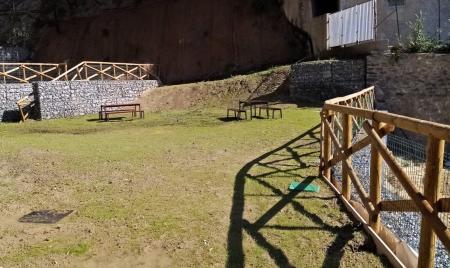
Area characterisation:
The Municipality of Genova has transformed the Gavoglio area in the Lagaccio district into a 10000 m2 urban park. The former military barracks in the area have been demolished and the area has developed into a public, inclusive and sustainable urban park built by almost entirely nature-based solutions. All functions of the park have been designed to be compatible with nature and the project involved the implementation of 12 different nature-based solutions.
Objective:
The city of Genoa experiences acute densification and lack of public green spaces, making urban heat stress a pronounced challenge. Air pollution and biodiversity loss are among the other challenges Genova targeted to address through NbS implementation.
Potential impacts/benefits:
Genova is known as a high-risk area for flooding due to the amount of rain that falls on the city. The infiltration basin helps improving the infiltration of water into the ground and reduces water runoff in the lower part of the city as the Gavoglio park is located upstream. The infiltration basin also contributes to the improvement of water and soil quality as well as enhanced biodiversity through the provision of habitat for wildlife. The concentration levels of NO2 and O3 at the reference site in Via Napoli was significantly (1.5 to 3 times) greater than the one recorded in Gavoglio during the current data acquisition period, with a peak in autumn-winter time. Survey among the stakeholders indicated that the largest number of respondents (55%) quantified the increase in values for residential properties between 6% and 10%. Approximately 4925 m3 of demolition materials were reused on site.
Actions:
Infiltration basin is a vegetated depression designed to hold runoff from impervious surfaces, allow the settling of sediments and associated pollutants. Infiltration systems allow water runoff to infiltrate into the ground over a period of time, in order to reduce the volume of runoff during a rainfall event. The detention time is approximately 48/72 hours and the 50% of their storage volume must be disposed of within 24 hours. Infiltration basins is dry except in periods of heavy rainfall. Above the rocky substrate there is the cultivation soil with an average thickness of 20 cm. Mix of Festuca arudinacea and Cynodon dactilon is used.
Transferability of result:
Infiltration basins are flat, vegetated areas that are usually dry. After heavy rainfall, water fills up the basin and soaks into the ground. While often planted with grass, additional vegetation types can be integrated into infiltration basins, creating habitats for wildlife thereby supporting biodiversity and improving aesthetic appeal. . Local precipitation intensity and soil conditions (e.g. permeability and infiltration capacity) as well as available space should be considered.
Lessons learnt:
Nature-based solutions offer an integrative direction for multidisciplinary cooperation, but the cooperation must be facilitated carefully. Citizens are willing to actively participate in co-creation and co-monitoring if tools and means of participant retention are carefully considered and applied.
Organisations:
City of Genova, https://smart.comune.genova.it/
LAND Italia, https://www.landsrl.com/
NBS goals:
- Enhancing sustainable urbanization
- Developing climate change adaptation
- Improving risk management and resilience
- Urban regeneration through nature-based solutions
- Nature-based solutions for improving well-being in urban areas
- Multi-functional nature-based watershed management and ecosystem restoration
NBS benefits:
- Flood peak reduction
- Increase infiltration / Water storage
- Reduce flood risk
- Reduce run-off
- Improve connectivity and functionality of green and blue infrastructures
- Increase Biodiversity
- Changing image of the urban environment
- Creation of green jobs relating to construction & maintenance of NBS
- Increase amount of green open spaces for residents
- Increase awareness of NBS solution & their effectiveness and co benefits
- Increase social interaction